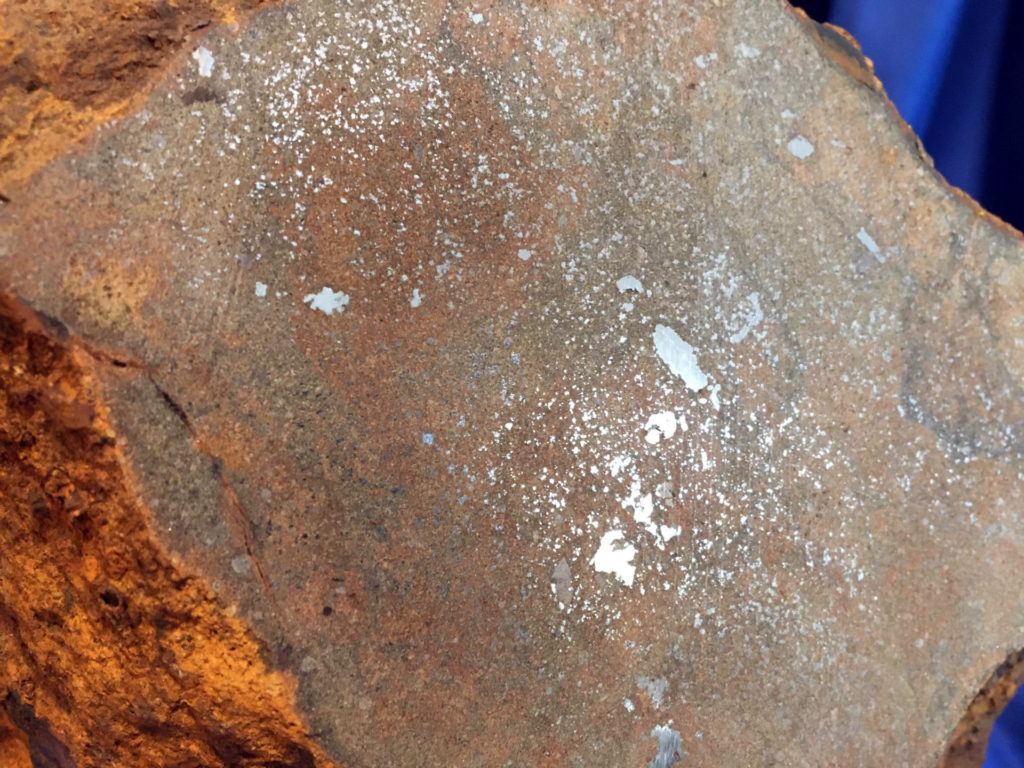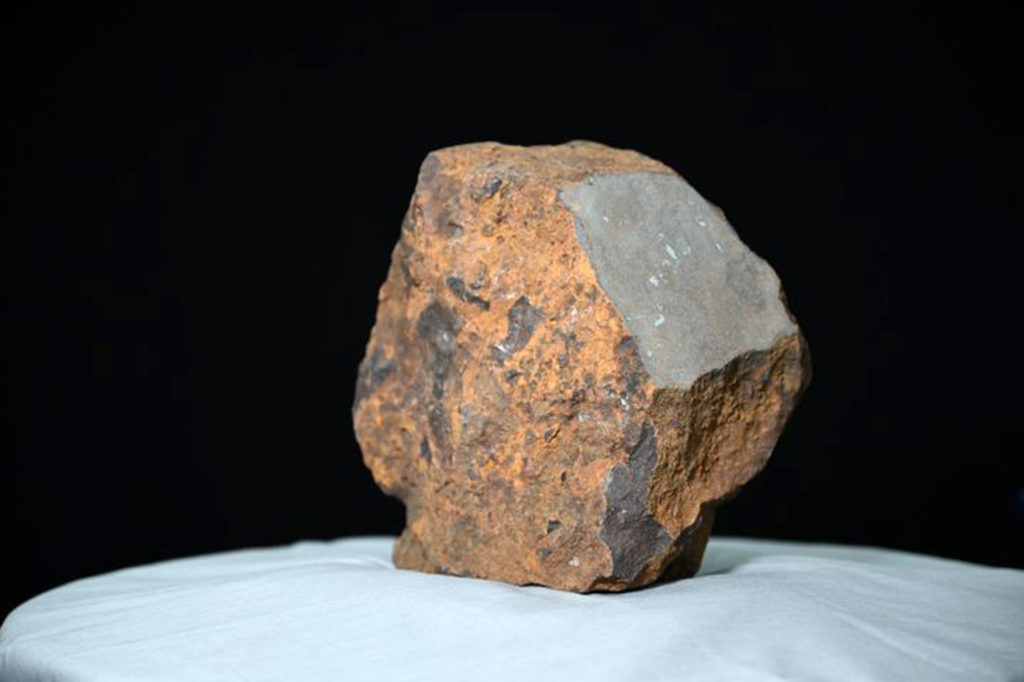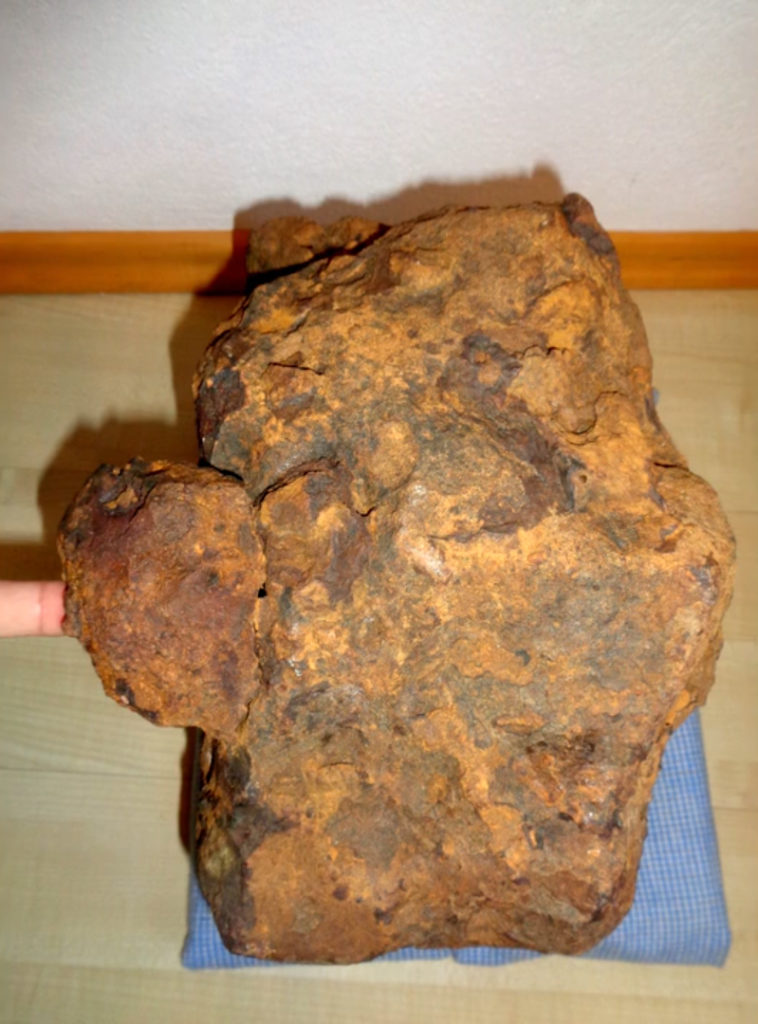Blaubeuren
Blaubeuren (30.670 kg, H4-5 breccia, S2, W3) meteorite find (1989) in Blaubeuren-Weiler, Alb-Donau district, Baden-Württemberg, Germany
In 1989 the 38-year old former Telekom employee Hansjörg Bayer was digging a hole at or near location 48°24’6″N, 9°46’1″E in his garden in Blaubeuren-Weiler to lay an empty pipe for a power cable of a garden floodlight when he hit a weathered rocky mass weighing 30.260 kilograms with his pickaxe at a depth of about 50 to 70 centimeters. He dug it out and was surprised about its weight. He noticed that the mass (28 x 25 x 20 cm, density 3.34 gram/cm³) was somehow special and magnetic. He wanted to keep it. Because it had always been in the way he kept it at about three different locations in his garden between 1989 and 2015. In 2015 Bayer almost took it to the local recycling depot together with other garden trash but when it was already on the car trailer he thought about it for another night, changed his mind and took it down to keep it in an old wardrobe in his basement until January 2020 when, while tidying up his basement, he became curious again and contacted the Institut für Planetenforschung of the German Deutsche Zentrum für Luft- und Raumfahrt (DLR). Professor Heike Rauer and Professor Jürgen Oberst established contact to Dieter Heinlein. Bayer phoned Heinlein and sent photos of his find. Additionally, he sent a 23.4-gram fragment which he had chipped from the rock. Heinlein cut the rock and when he saw the lithology could confirm that the rock was in fact a meteorite, an ordinary chondrite. On 9 February 2020 Bayer (now 69 years old) gave the meteorite to Heinlein for analysis. In April another 410-gram fragment was discovered in Bayer’s garden. It was found on the cover of a well where Bayer put it in 1989. The fragment probably broke off during the excavation of the main mass. The 410-gram fragment was cut for radioisotope analysis and a 384-gram mass remained. Other fragments which must have fallen off in 1989 have most likely been thrown away. On 30 May 2020 a 576-gram slab was cut off the 30-kilogram mass with a big saw by a mason in Mindelheim. The intention was to make the mass more attractive for presentation by also revealing the lithology of the H-chondrite. The 576-gram slab is being used for radioisotope analyses at the Helmholtz-Zentrum Dresden-Rossendorf to determine its terrestrial age. Dr. Beda Hofmann from the Natural History Museum in Bern measured Barium and Strontium isotopes with an energy dispersive X-Ray fluorescence spectrometer to confirm that the meteorite had actually weathered in the soil of the claimed find location and not in an African desert. To analyse the meteorite’s terrestrial age radioisotopes of the meteorite and soil samples from the find location were analysed by Dr. Detlev Degering at the VKTA laboratory for environmental and radionuclide analysis. Measuring 14C and 10Be Prof. Tim Jull in Tucson calculated that the terrestrial age of Blaubeuren is about 10,000 years. The classification was performed by Professor Kerstin Klemm and Professor Addi Bischoff at the University of Münster (WWU). On 16 June 2020 the results were sent to the NomCom of the Meteoritical Society by Prof. Kerstin Klemm. The find was officially registered in the Meteoritical Bulletin as Blaubeuren on 7 July 2020. The finder would like to see the meteorite being exposed in a museum so that it is available to the public. Two museums are reported to have contacted Bayer concerning an acquisition of the meteorite. On 15 July 2020 the DLR published a press release about the find which was republished by the WWU the following day. On 17 July the meteorite was presented to the media and public in the Observatory Laupheim. On 29 July the meteorite was presented at the Urzeitliches Museum in Blaubeuren where it was exhibited from 30 July – 25 October 2020. Due to the cancellation of the show the meteorite was not presented at the Munich Fair at booth A5.432 (30 October – 1 November 2020). On 16 June 2021 the meteorite was scanned with a GOM ATOS Q 3D-scanner in Sonneberg. A digital 3D model of the meteorite’s main mass has been made (see video below).
.

The weathered Blaubeuren meteorite. Photo: Gabriele Heinlein

The weathered brecciated H-chondrite lithology. Photo: DLR

The weathered brecciated H-chondrite lithology of the cut off 576-gram slab immediately after the cutting. Photo: D. Heinlein

Blaubeuren meteorite at the Laupheim Observatory on 17 July 2020. Photo: Felix Kästle/dpa

The cut fragments (17.75 grams and 2.95 grams) of the broken off fragment Bayer sent to Heinlein for analysis. This fragment confirmed the meteoritic nature of the find. Photo: Gabriele Heinlein

The 410-gram fragment next to the 30-kilogram main mass. Photo: D. Heinlein

The 410-gram fragment fits perfectly to the 30-kilogram main mass. Photo: D. Heinlein
3D-Scan of the Blaubeuren meteorite (Video: Digimold Sonneberg)
Scientific literature
Addi Bischoff, Jakob Storz, Jean-Alix Barrat, Dieter Heinlein, A. J. Timothy Jull, Silke Merchel, Andreas Pack, Georg Rugel
MAPS, Version of Record online: 17 January 2022
Media
Press release (DLR)
Press release (WWU)
Press conference with Dieter Heinlein at the Laupheim Observatory on 17 July 2020
Tagesschau TV report (17 July 2020)
Interview with Dieter Heinlein (Tagesschau, 17 July 2020)
SWR TV (17 July 2020) Interview with Dieter Heinlein Audio: SWRBrisant, ARD/MDR TV (17 July 2020): LINK
TV report. RegioTV (17 July 2020): LINK
TV report on the Blaubeuren exhibition. RegioTV (29 July 2020): LINK
Dieter Heinlein discussing the Blaubeuren meteorite with Karl Urban (Podcast, 22 July 2020)Ausserirdisches Schwergewicht
by Ulrich Köhler
in: DLR Magazin (Issue 166, 2020, pp.48-49)































